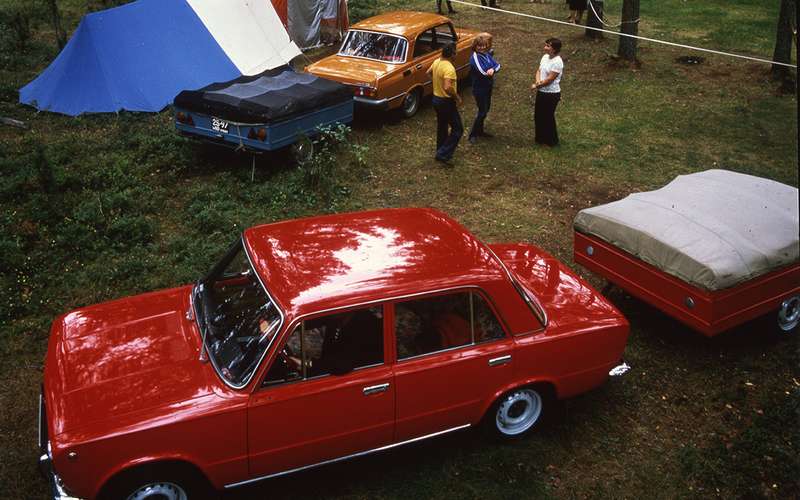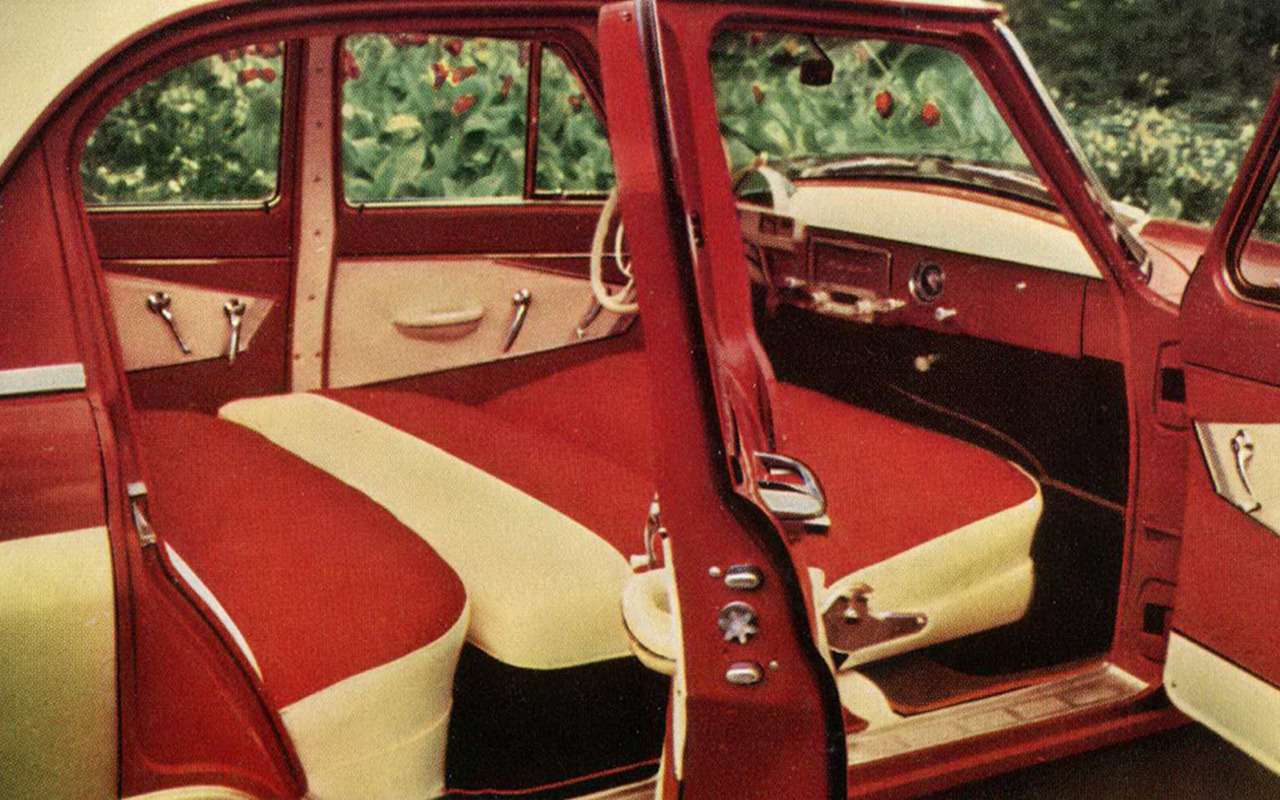Three wheels, three people
Real story. In the early 70s, the Leningrad family: father, mother and daughter, regularly went on vacation from Leningrad to Alushta. And not by car, but with a motorcycle with sidecar! Almost two and a half thousand kilometers!
Tourist idyll of the past in a modern interpretation.
We reached Moscow, rested for a day and headed south. Sleeping in a tent. How the necessary items were also accommodated in Java is a mystery.
I think it’s heroes! In addition to them, the life of car tourists of those years is the height of comfort! Although on four wheels it was not so easy.

Romance with bus and distributor
Motor tourism began to flourish in the 1950s, along with the growth in the number of passenger cars. It is no coincidence that several popular films are devoted to this pastime: “To the Black Sea” (1957), directed by Andrei Tutyshkin, “The Driver Willy-nilly” (1958) by Nadezhda Kosheverova and, of course, “Three Plus Two ” (1963) by Genrikh Oganesyan.
“Behind the wheel” then gave a lot of advice to tourists. One of them: it is better to go on holiday with a group of several cars. In addition, preferably one model. It was not difficult then: Moskvich, Pobeda were available to Soviet citizens, and Volga was available to a few lucky ones.

The set “emergency”, without which an experienced motorist did not drive beyond the nearest area, was the same for everyone. There was always a 20 liter can of petrol in the trunk. Better yet, two. After all, gas stations were rare, they gathered long lines and sometimes they just waited for petrol, which had “not yet been delivered.” By the way, the pandemonium at gas stations in the movies of the 1950s is portrayed quite realistically.
In any case, the stock of spare parts for an experienced motorist included candles, a slide and a circuit breaker-distributor cap (and preferably the circuit distributor itself), an ignition coil, a pump and generator drive belt. Of course, the set also included a canister of oil (volume – depending on consumption) and brake fluid (especially on older cars, it suddenly left the tanks). Therefore, the most economical also carried with them at least one spare brake cylinder, but more often – cuffs for it.
help yourself
Ideally, the driver should have at least been able to carry out minor repairs himself. Admittedly, in those years, there were far more people who stopped at a call for help than those who didn’t. How else can you call for help?
I’m not even talking about mobile phones, nobody could have imagined that. Already in 1980, my friend drove his ZAZ-968 home along the highway from Minsk. About a hundred kilometers from Moscow, Zaporozhets had broken a half shaft (it happened to them). And for the Olympics-80, beautiful telephone booths were built on the highway connecting Moscow with Europe. We just didn’t have time to connect the devices.
Traffic cops laughed to tears at the naive man who tried to call from this booth! True, out of compassion, they also engaged him to a local craftsman who welded the removed thru-axle.
From this moral: without a cable in the trunk, a normal Soviet person would not go anywhere. Admittedly, hanging behind a truck for 100 km is an unpleasant activity. But anything is better than leaving the car on the highway and looking for a part that will take days to complete.
And finally, the car must have a complete set of tools (there are very few!), including a chisel and a hammer. In case that!
Raw rubber, hot vulcanizer
Particularly careful, sometimes loaded a second spare tire on the roof or carried one or two cameras. Removing a wheel without damaging it and yourself is an art in itself. If successful, the nail should be pulled out, the camera should be replaced. Or repair.
Few people now know what a vulcanizer is. The puncture site of the chamber was cleaned with a file, there a piece of special so-called rough rubber was applied and clamped between two surfaces. They were heated by electricity from the battery.
I’ve also found gasoline vulcanizers. One of the surfaces clamping the camera is combined with a petrol bath, which is set on fire and waiting for the rubber to heat up and stick. The main thing is not to burn anything and anyone with this “thermonuclear” device!
Turtle Principle
Of course we drove slower than now. It’s not about speed, but about your own mobile accommodation for the night.

Only a lucky few stayed in retirement homes, guest houses, campsites and private apartments. The rest were satisfied with the tent. And some chose such a holiday on principle (as they said then, “wanted”): they set up their own “guest house” where they wanted, and for free.

It was possible to sleep in the car, like the characters in the picture “Three plus two”. But the two of us are still back and forth, and even in the Volga, the three of us are busy. By the way, sofas folding into a flat “rookery” were then considered a car virtue not only in the USSR, but also in Europe and even in the USA.

Roof tents appeared in the 70s. The “house” in folded form drove there, and at night it was unfolded and equipped with a ladder.

A tourist’s dream is a trailer. Thanks to him, you can slightly unload the interior and trunk and take home cheap fruits and vegetables. Until the 1970s, trailers were rare. Then they became available.

In the early 1970s, a miracle design from the Urals plant “Iskra” called Skif appeared. The trailer, only 2900 mm long, together with the drawbar, was suitable to be towed by any Soviet car – from Zaporozhets to the Volga.
Outwardly, the Skif resembled an ordinary cargo trailer, but with a lid. Since the mass was only 230 kg (later declared 260 kg), this free space was supplemented with the necessary tools for the journey. The wheels of the trailer were small, coming from a motorized carriage, but the ground clearance was comparable to that of an SUV: 240-260 mm.
And in the parking lot (oh, wonder!) A tent with an area of 6 m2 was easy to assemble from a trailer2 (in some apartments the kitchen was smaller then). In addition, the set included a folding table and four chairs.
Quite decent sleeping places for four appeared in the tent. And under the benches – storage boxes.
The kit also included a tented veranda with an area of another 3 m2. In general it turned out to be a kind of mobile house. In the Skif-1M version, the materials of the awning have been improved (in the beginning it regularly leaked in heavy rain) and the upholstery of the berths. There was even a carpet on the floor. Later, other modifications of the Skif were born.
Car tourism has been a serious test for experienced and strong-willed people for years. But the pluses are clear: the ability to stop wherever you want, to visit places where the “horseless” can hardly get to. Overall a feeling of freedom and happiness! And it was the stronger, the more suffering.
- “Behind the wheel” can be read VKontakte.
The expert “Behind the wheel” recalled interesting facts and found illustrations from the 1950s-1970s.







